Tandem bike: history, design, manufacturers and selection
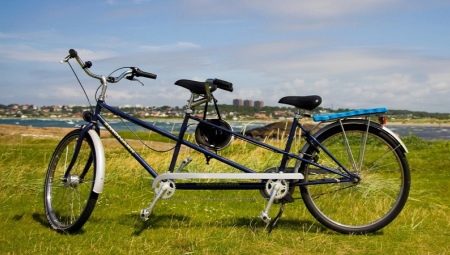
A tandem is a bicycle for two. Regardless of how it was received, its purpose is joint trips and even closer contact with a partner.
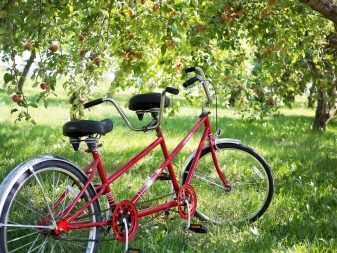

History of creation
1898 was the year the tandem bicycle was patented. This product is patented by Mikael Pedersen. The first "tandem" weighed 24 pounds (about 10 kg). It was useful to the soldiers of the Second Anglo-Boer and World War II. In the 60s of the last century, the reputation of tandems was spoiled by low-quality steel - it sagged, the frame simply could not support double human weight. Decades later, the UK's first tandem community was established.
Then the French company L&G launched a production line for the production of tandem bicycles. The Americans, represented by Santana Cycles, continued this business only in 1976, having eliminated all the shortcomings of their predecessors, whose tandems had flaws.
Today "tandem bikes" are in demand among lovers and married couples, although mostly people in these categories buy bicycles separately.
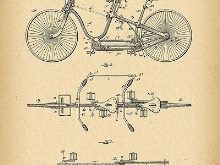


Advantages and disadvantages
Let's take a look at the merits of a tandem bike first.
- Encouraging children to ride a bike - you control, and the child sits in the back on the second seat. After 10 years, when the child reaches with his feet to the bicycle pedals, you can refuse to sit on the frame of a regular bike or use a child's bike - he is already able to pedal and confidently stay in the saddle.
- Saving energy when traveling or on long trips out of town together. This is mainly used by couples in love and newlyweds. If the leader is tired, he can become a follower for a while - replace him.Two people drive a 10-15 kg bike lighter than each one of about the same weight. You will feel this effect when driving against the wind and / or uphill - only one person resists the wind here, and not both. On the highway, the speed of the tandem bike is that of a road bike.
- Closer communication - you are closer to each other, and you do not need to shout over the noise of the streets and highways. Tandem is a great way to test the strength of your relationship or marriage.
- The increased strength and durability of the bike tandem is beyond doubt. The double box rims are reinforced like a downhill bike, the frame and more spokes (over 36) are perfect for even the most well-fed riders.
- It is more difficult to steal a tandem - two thieves should act together. If there is only one thief, he is unlikely to travel far in tandem, because a second member of the criminal group is needed.
- Opportunity to overtake any cyclist - even the most trained. The tandem ride down the highway downhill is comparable to the speed of a city bus.
- The second rider, unable to steer, assists in everything else from the rear and side view of the road. In addition, he may have one or both hands free.
- The second rider may be blind or visually impaired. This gives him the opportunity to take part in competitions between riders using tandems.
- It is impossible to lag behind on tandem. If the second of the riders is still underdeveloped physically enough to travel at least 30 km, then his place is behind. If you gain experience and practice, you can change, which cannot be said about every cyclist who has his own bike.
- Tandem allows you not to carry spare parts for two bicycles. This applies to the rear cassette and derailleur, chain, brakes, steering wheel and wheels.
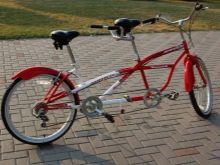

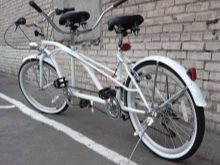
There are also disadvantages to the cycling tandem.
- It is difficult to get around on a tandem bike alone. You definitely need a second travel companion.
- It is almost impossible to tow it. If even an ordinary road or mountain bike in a recumbent position can be fixed on the trunk of a second one of the same - and with grief to carry it in half, then forget about this method of tandem delivery. If you switch bicycles, you will not leave either: you and an unloaded tandem are unlikely to be able to drive alone.
- It is difficult to turn around on narrow-lane streets, in a narrow alley in a park, or on a sidewalk. The length of the tandem is almost two lengths of a simple road bike with all the consequences.
- The tandem weighs up to 22 kg. Even the heaviest road bike or mountain bike, driven by one person, weighs no more than 16 kg. Because of this, it is difficult to travel alone in tandem.
- The brakes are another weak point. Whatever their principle of operation - a foot brake, brake pads on the rims or a disc structure - they experience a double load during hard braking.
- The person sitting behind can hardly see where both bikers are going - the front (steering) cyclist obstructs the view with his back.
- You cannot be alone - especially when you ride one shared bike, and not two separate ones.
- The tandem is much more difficult to carry up the stairs if you live in an apartment building, and even on one of the last floors. Unlike a regular bicycle, it will not fit into a regular passenger elevator - only a working freight one can deliver it to your floor. A tandem cannot be transported in a city bus, it is difficult to transport it on a train or by an electric train, and on an airplane you will pay much more for its transportation.
- Finally, a tandem bike costs several times more than a budget mountain or road bike. It is not sold in most sports hypermarkets, the best option is to order it from a city where there is a factory or an assembly company that supplies such bicycles to the domestic market.
For those who want to ride a tandem, such bicycles are available for rent in million-plus cities.
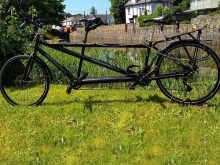
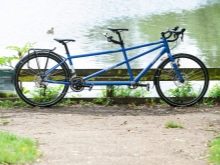

Design
The length of a standard two-wheeled bike tandem is 2.2-2.3 m. This is a two-seater bike with two seats. One of the rudders is not involved in control. The chain sprocket is 60-tooth, the rest are 12-tooth. The chain length is up to 3 m. For a regular bicycle, the chain length does not exceed 1.5 m. The number of spokes in wheels is up to 96; fewer spokes would not support the weight of two riders and twice the speed of a city bike.
The steering wheel on which the second rider is holding does not participate in the steering. But rotating the rear pedals, in sync with the front ones, rotated by the leading biker - he provides assistance in driving, and is not a "dead weight".
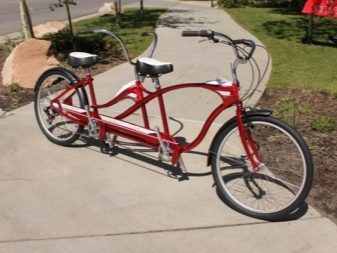
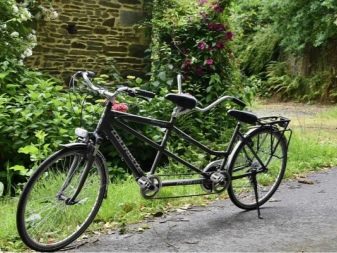
The three-wheel tandem is more stable - the rear sprockets are not connected directly to the wheel hub, but to the axle that controls the two rear wheels rotating synchronously. The consumer pays for this with even greater weight and difficulty in overclocking. The effort each biker makes in such a tandem is comparable to the force with which each of them rides his own simple bike - the axle and two wheels are too heavy.
The speed of even a 1-speed tandem is also achieved by the 2-star rear pedal carriage. In fact, the lead biker pedals a little slower than the "follower". If the sprocket of the front pedal carriage has 60 teeth, then on the smaller sprocket, where the first (inter-pedal) chain is wound, there may be, for example, 40-50 teeth.
From the neighboring, larger sprocket of the rear pedals, the second (main) chain is already started on the rear sprocket (or multistage cassette) of the rear wheel. This is what improves the efficiency of the efforts made by the "stock" cyclist, while the front one only effectively adds its own effort. This is another reason why it is impossible to hijack a tandem alone... Tandem bike for adults - model with a full frame size of 21-22 inches. The four-wheeled tandem looks more like a velomobile.

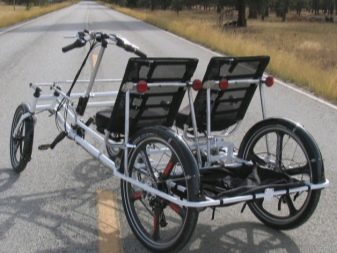
You can make your own tandem of two road or mountain bikes. To do this, the rear hub of the front bicycle must have a longer hub (axle), onto which the fork of the rear bicycle is put on, from which its front wheel is removed. If the frames are not permanently welded to each other, you can "separate" at any time. This method is good when one of the bicycles has a broken front wheel rim. In this case, the control (steering wheel) of the rear bicycle is blocked - the rear wheel of the front bicycle is rigidly installed. It will turn out to be another version of a three-wheeled tandem - in it there will be not two wheels behind, but one.
Ideas for tandems - folding, with a motor (for example, with a gasoline engine), electric tandem and others - have not yet received any reasonable distribution.... This impossibility is connected with the complexity of implementation and even fewer people who want to experiment with a speed that is an order of magnitude higher - which is provided by fuel or electric traction.

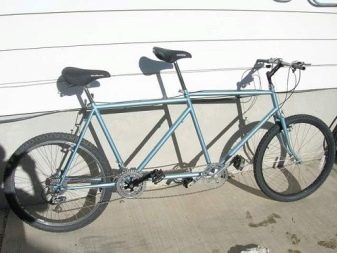
How to learn to ride?
Riding in tandem is the result of the united efforts of both participants. You must know exactly when to drive off, as well as when and where to brake - braking for a 180 kg system is much more prolonged due to inertia, here the braking distance will be lengthened... Driving too fast or making a wrong turn can injure both riders. If the tandem has several speeds, then they are switched by the master.
Since the rear rider cannot see the road ahead, any pothole or bump will come as a surprise or even shock to him. Hence, the front rider must control the quality of the road - and avoid such obstacles - and not just steer and brake.


When changing speeds, the lead cyclist warns the rear rider to relieve the pedal force for a few seconds. Failure to do so will result in accelerated wear and premature derailleur failure. Don't lose out on high cadence when climbing uphill - this is another reason why it's important to work together in tandem.
If you decide to drive some distance together, standing on the pedals, then it is advisable for both to get up. A standing person has no way to slow down faster - especially when the bike is overloaded with bags, or both riders are too fat. This is true for both the presenter and the stoker cyclist.

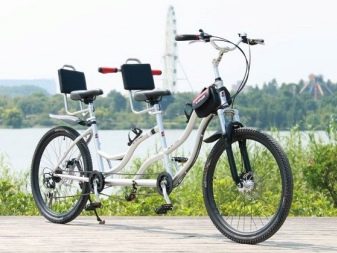
Popular manufacturers
The production of tandems is extremely limited due to their low prevalence. Only a dozen companies produce bicycle tandems:
- Bilenky Cycle Works,
- Bohemian Bicycles,
- Cannondale Bicycle Corporation,
- Co-Motion Cycles,
- Dawes Cycles,
- KHS Bicycles,
- Santana Cycles,
- Schwinn Bicycle Company,
- Torker.
- Trek Bicycle Corporation.
At the last count, economists and marketers will take more than a dozen years for them to reach the level of at least road bikes in demand, not to mention full-fledged competition with mountain bikes.
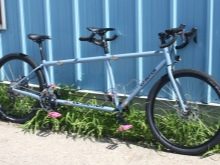
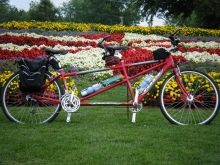
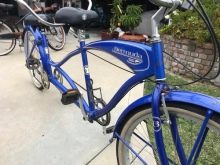
How to choose?
The choice of a tandem is made according to the same parameters as a regular bicycle is selected:
- diameter and width of wheels;
- number of speeds;
- material of the frame, bushings, rims, front steering wheel fork;
- dimensions and weight;
- depreciation parameters (for tandem hardtails and double suspensions);
- number of wheels (including tricycles);
- steering wheel adjustment and several other parameters that are no less important when choosing.

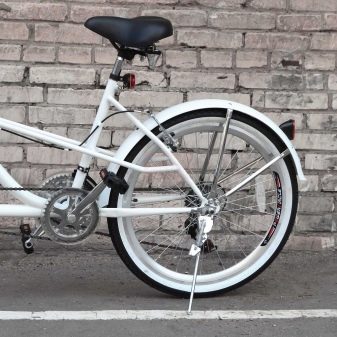
However, there are several different parameters:
- the number of riders (there are tandems for three or more people);
- adjustable rear stem and saddle;
- the number of stars of the additional system.
In the latter case, we are talking about an additional (rear) pedal carriage. In any case, your safety depends on the quality of the bike tandem.
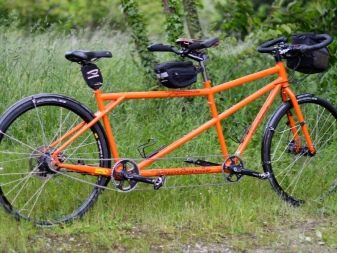

In the next video, you will find a review of the Forward 5352 tandem bike.








